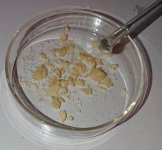Innocent
Rising Star
Hi all
After making this discovery I've rushed back to report the findings after registering several years ago. Had to spend 3 days hunting through introductory essays from years ago trying to find myself and remember my username...
After growing P. Viridis for several years an extraction has finally been made, but not by choice, but instead it was forced by the plant or the perfect storm of conditions.
It's a single plant, maybe 1.2M tall. It was grown from a pre-rooted cutting of 20cm. Harvesting was not desired, the growth of the plant was much more important.
The plant was started indoors under red/blue LED lights 3 years ago and moved outside under corrugated shade sheets last year in a very small plastic greenhouse (DIY). Since the move outdoors, it has suffered from regular neglect (only watered when visibly suffering water deficiency, probably every 1-2 weeks), fertiliser burn, weather too hot, humidity wildly varying from one extreme to another, temperatures swinging between 2 and 40 degrees C, fungal infections and most recently scale insects. The plant has never felt the rain.
Most recently, P. Alba was removed from the shared greenhouse (separate pots) leaving P. Viridis on its own. A heavy scale infestation was noted with many ants attracted to some very sticky secretions the plant had somehow left on the floor nearby (leaves also were coated). The plant has been sprayed with myclobutanil (<0.05g) in the last year for fungal issues. The plant was sprayed with polysulfide sulfur a.k.a. lime sulfur (~4g) within the last month to treat the severe scale infection. At some point within the following weeks the plant was mildly disturbed during the evening (shaken) and a significant portion of the leaves on the plant detached and dropped to the floor (green, looking fresh).
The leaves were immediately collected, rinsed under running water and frozen (both for preservation and to rupture the cells to increase yield. Approx two weeks later the leaves were defrosted at room temperature overnight and the residual water frozen to the leaves (from the rinse) evaporated.
These effectively fresh (not dried) leaves weighed exactly 80g (+/- 1g).
Following a method derived and slightly modified from the DMT handbook's extraction method (that used M. Tenuiflora root bark) an extraction was performed. Filtration of acidic solution through was via filter cloth followed by filtration of the organic solvent via quantitative filter paper.
This extraction yielded 270mg (+/- 2mg) of both white and off-white fine, powdery crystals via freeze precipitation for 24 hours (attached) and a small amount (0.1mL?) of yellow/green oil remaining in the evaporation basin after evaporation of remaining solvent. The purification steps in the guide were not performed.
This is a yield of 0.27g / 80g = 0.3375% yield by weight from fresh leaves.
If existing literature is anything to go by, this weight should be mostly N,N-DMT.
Existing literature also mentioned a yield of up to 0.61% dry mass. Assuming these leaves were dried prior to extraction their mass would drop maybe 90% (estimated, anyone got real numbers for moisture content?) and we'd be looking at an equivalent of 0.27g / 8g = 3.375% dry weight equivalent.
This would be insane if true and I refuse to believe it, yet.
Either my estimate of 90% moisture content is wrong and/or the extract is significantly impure.
What could it be contaminated with? Could it possibly be polysulfide sulfur?
Should the extract be dissolved into hydrochloric acid and brought straight back to base? The polysulfide sulfur shouldn't be soluble in water.. but then I wouldn't expect a highly contaminated end product if it was pulled with boiling acidic water.
Advice? Does it need purification? Leave it? How does it look?
After making this discovery I've rushed back to report the findings after registering several years ago. Had to spend 3 days hunting through introductory essays from years ago trying to find myself and remember my username...
After growing P. Viridis for several years an extraction has finally been made, but not by choice, but instead it was forced by the plant or the perfect storm of conditions.
It's a single plant, maybe 1.2M tall. It was grown from a pre-rooted cutting of 20cm. Harvesting was not desired, the growth of the plant was much more important.
The plant was started indoors under red/blue LED lights 3 years ago and moved outside under corrugated shade sheets last year in a very small plastic greenhouse (DIY). Since the move outdoors, it has suffered from regular neglect (only watered when visibly suffering water deficiency, probably every 1-2 weeks), fertiliser burn, weather too hot, humidity wildly varying from one extreme to another, temperatures swinging between 2 and 40 degrees C, fungal infections and most recently scale insects. The plant has never felt the rain.
Most recently, P. Alba was removed from the shared greenhouse (separate pots) leaving P. Viridis on its own. A heavy scale infestation was noted with many ants attracted to some very sticky secretions the plant had somehow left on the floor nearby (leaves also were coated). The plant has been sprayed with myclobutanil (<0.05g) in the last year for fungal issues. The plant was sprayed with polysulfide sulfur a.k.a. lime sulfur (~4g) within the last month to treat the severe scale infection. At some point within the following weeks the plant was mildly disturbed during the evening (shaken) and a significant portion of the leaves on the plant detached and dropped to the floor (green, looking fresh).
The leaves were immediately collected, rinsed under running water and frozen (both for preservation and to rupture the cells to increase yield. Approx two weeks later the leaves were defrosted at room temperature overnight and the residual water frozen to the leaves (from the rinse) evaporated.
These effectively fresh (not dried) leaves weighed exactly 80g (+/- 1g).
Following a method derived and slightly modified from the DMT handbook's extraction method (that used M. Tenuiflora root bark) an extraction was performed. Filtration of acidic solution through was via filter cloth followed by filtration of the organic solvent via quantitative filter paper.
This extraction yielded 270mg (+/- 2mg) of both white and off-white fine, powdery crystals via freeze precipitation for 24 hours (attached) and a small amount (0.1mL?) of yellow/green oil remaining in the evaporation basin after evaporation of remaining solvent. The purification steps in the guide were not performed.
This is a yield of 0.27g / 80g = 0.3375% yield by weight from fresh leaves.
If existing literature is anything to go by, this weight should be mostly N,N-DMT.
Existing literature also mentioned a yield of up to 0.61% dry mass. Assuming these leaves were dried prior to extraction their mass would drop maybe 90% (estimated, anyone got real numbers for moisture content?) and we'd be looking at an equivalent of 0.27g / 8g = 3.375% dry weight equivalent.
This would be insane if true and I refuse to believe it, yet.
Either my estimate of 90% moisture content is wrong and/or the extract is significantly impure.
What could it be contaminated with? Could it possibly be polysulfide sulfur?
Should the extract be dissolved into hydrochloric acid and brought straight back to base? The polysulfide sulfur shouldn't be soluble in water.. but then I wouldn't expect a highly contaminated end product if it was pulled with boiling acidic water.
Advice? Does it need purification? Leave it? How does it look?





